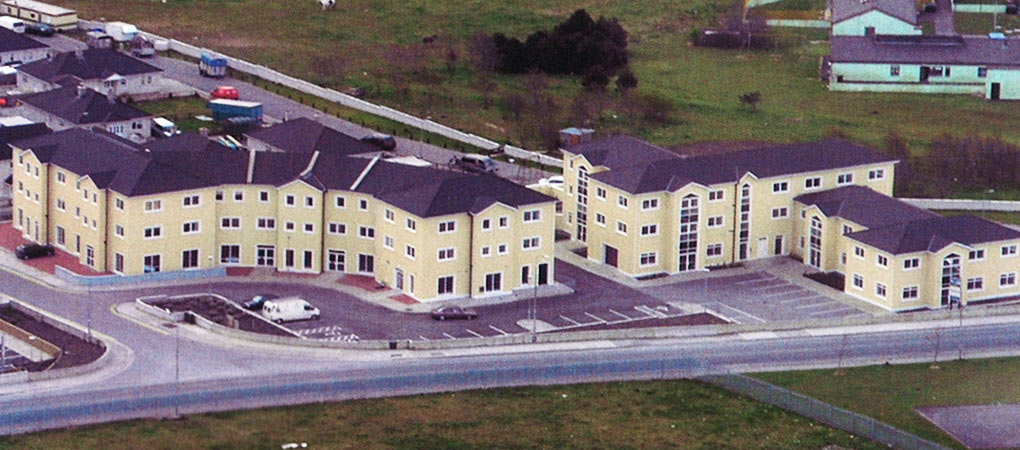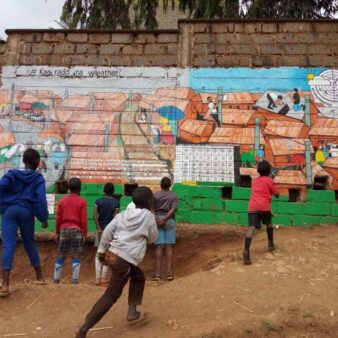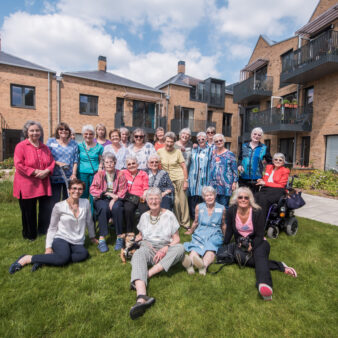The Ballybane Neighbourhood project works to bring about social and economic regeneration in an area of high-density, low demand social housing. 216 mixed-tenure dwellings have been built including bespoke accommodation developed in partnership with the local Traveller community. A medical centre, 15 enterprise units, a resource centre, library and retail units have been developed using an innovative funding partnership between Galway City Council and the local credit union.
Project Description
Aims and Objectives
- Address inadequate housing conditions for existing residents and provide additional social housing for local people, as well as encouraging mixed tenure through the provision of homes for owner-occupation.
- Provide a community focal point with a Neighbourhood Village Centre.
- Stimulate economic activity to provide local jobs and make the area an attractive place for economic investment.
- Change the perception of the area in the eyes of existing and potential residents, inward investors and employers.
- Empower the community to take their place in the economic renaissance of the City of Galway.
Project context
Located three miles to the east of Galway, Ireland’s third largest city, the area lacked local services and had low educational skill levels, high rates of unemployment high incidence of lone parent families and a high dependence on the state. The standard of housing was generally poor and characterised by bad design and layout.
Galway City Council, the local, democratically elected, governing body, sought to address the inadequate housing conditions and change the perception of Ballybane in the eyes of existing and potential residents, inward investors and employers. The council has worked in partnership with the community residents to provide a community focal point and social facilities, stimulate economic activity and has collaborated with the local Traveller community to address their accommodation needs. The vehicle for this development was an integrated Master Plan. The plan intentionally promoted a mixed-income community to address the very low average incomes in the area that were identified as a key factor precipitating the underdevelopment of services. As well as housing, the Master Plan envisaged a resource centre, community centre, crèche facility, hierarchy of parks and open space and enterprise units to stimulate local business.
Key features
To date 216 dwellings have been built with a range of tenures to encourage a social mix. Seventy-five of the houses are for owner occupation, 125 for social renting and 16 especially designed for the Traveller community. Specifically designed units have been provided for the elderly and those with special needs. The houses have been built to high environmental standards and there is no disparity in size or design between tenure types. The project has also facilitated the building of a Neighbourhood Village Centre incorporating 15 enterprise units. A further 271-unit mixed tenure development will be completed in 2007, together with more Traveller Housing Units, community facilities and a further 18 enterprise units to facilitate start-up businesses.
The total cost of the project was US$86 million. This cost was met from a range of sources including national and local government funding, the sale of private housing units on the open market, commercial borrowings and local fundraising.
Partnership with the Traveller community
A key component in transforming the area has been addressing the needs of a large Traveller encampment that had been located in the area for 30 years. The Traveller community were dissatisfied with the lack of services that the encampment had and the effect this had on living conditions. A Traveller Group Housing Scheme of 24 units developed in the 1980s had become substandard and unsuitable, with significant problems of dumping, wire-burning (to extract copper), joy-riding and other anti-social behaviour. This acted as a major disincentive to people or commercial enterprise locating in the area.
The project has provided Traveller-specific accommodation in two family groupings of eight houses each. The existing encampment was cleared with the agreement of residents and the local council and has resulted in a sharp decline in the anti-social problems previously prevalent.
The design of the accommodation was developed in partnership with the Traveller community. A range of options were considered, including permanent and transient halting sites, Traveller group schemes and standard housing, before Traveller-specific accommodation was developed. This took into account the Travellers’ culture and needs and offered ground-floor accommodation, space at the rear for storing caravans during the winter and a hard surface area to facilitate economic activity such as scrap collection, and recycling.
‘Home Zones’ have been incorporated into the development allowing the streets to become play and amenity areas and contributing to Galway’s role as a ‘Child-Friendly City’. ‘Home Zones’ foster a sense of community and aim to change the way that the streets are used. They consist of shared surfaces, indirect traffic routes, areas of planting and features used to indicate to traffic that they are entering a ‘home zone’.
The involvement of Ballybane residents in the planning and design of their neighbourhood is a key element of the project. The local media has been harnessed to encourage participation. Community leaders and other stakeholders are consulted on the key problems and priority actions required for development of the area. Management of the closure of the Traveller encampment, as well as the design and development of the land and the Traveller-specific accommodation, were performed in close consultation and liaison with the Travellers themselves, the Local Traveller Accommodation Consultative Committee (LTACC), Traveller Support Groups and officials concerned with issues of provision, management and maintenance of Traveller accommodation. Residents are included on the Board of Directors of the Ballybane Community Resource Centre Ltd and the Neighbourhood Village Centre, and are involved in running a range of local activities.
Covering costs
The Neighbourhood Village Centre that has been developed includes a medical centre, 15 enterprise units, a library and retail units. The US$10.4 million cost of the centre has been met through an innovative financial partnership between the council and the local St Columba’s Credit Union. For the purposes of the project the partnership formed a not for profit company (SCUUL Enterprises) which included representation form the City Council, the Credit Union and the local community. They borrowed funding from the parent Credit Union at an agreed five per cent interest rate. This was greater than the return usually realised on Credit Union investments (three per cent), and significantly lower than commercial borrowing rates. Areas of the Neighbourhood Village Centre were to be sold and leased to the market, and tax benefits are received as the area has been designated an Integrated Area Plan (IAP) under the Urban Renewal Act 1998. A surplus of US$3.9 million on the development of the Neighbourhood Village Centre generates a stream of income to support local services.
Impact
The project has had a great impact on the quality of life of the residents and in wider sphere:
- Traveller families accommodated in the illegal encampment and substandard accommodation have been re-housed within the community in housing specifically designed in consultation with them.
- Home zones foster a sense of community and safety, creating a ‘child-friendly’ area.
- Designing out crime: the design and planning of the area facilitates passive surveillance and traffic calming.
- There has been an overall increase in the reputation of the area, reflected in demand for housing and rise in house prices.
As a result of the success of the Ballybane project, Galway City Council’s housing development policy has been updated to ensure that all future developments will be mixed-tenure.
Why is it innovative?
- The integrated master planning process has built a community that is socially and economically sustainable, located in an attractive environment, with high quality public facilities and well connected to the wider urban context.
- The innovative partnership of the local Credit Union and the City Council has leveraged local community resources for the benefit of the local community without recourse to government subsidy.
- By concealing tenure differences, housing design has helped to emphasise similarities rather than differences between residents and therefore counteract the potential emergence of tenure prejudice
- Due to the redevelopment of the area it can now attract, and retain, individuals and families from a range of backgrounds and on a variety of incomes.
- The involvement of Traveller families, Traveller Support Groups and LTACC in the formulation of plans for their community and new accommodation was critical to the successful closure of the Traveller Encampment and demolition of Hillside Park.
- Introduction of Home Zones for the first time in Ireland.
- A structure of financial and other incentives has been put in place to attract investment, which would not otherwise locate in Ballybane. The Village Centre now acts as a catalyst for the economic and social regeneration of the area attracting inward investment, leading to a marked improvement in the economic status of the area.
- The funding model utilised in the developed of the Village Centre has the potential to be easily transferred to other projects. The working process is easy to adapt and understand.
What is the environmental impact?
The new dwellings have been built to the current standards of low embodied energy and appropriate use of energy and water resources.
Major open space in the area has been retained in the form of a large meadow broken into various zones, and accommodating a football pitch. Native woodland and indigenous trees will border green corridors that will provide ecological linkages between open spaces and amenity walkways throughout the residential area.
Is it financially sustainable?
Receipts from sales and leases of the Neighbourhood Village Centre have enabled SCCUL Enterprises Ltd. to realise sufficient funds to clear their costs of US$10.4 million and have a surplus fund of US$3.9 million. This surplus is now financing the construction of additional enterprise units on an adjacent site within the community and will continue to fund community services in the area. The sustainability of the approach has been emphasised by the return that has been realised by the members of the Credit Union as they invested to build the Village Centre. They received a five per cent return. This was higher than the usual three per cent return for credit union members, but has allowed SCUUL to build of the Centre using funds considerably cheaper than conventional commercial loans.
The delivery of the Master Plan from design to construction has been estimated to provide 300 person-years of employment. The provision of enterprise units within the community has generated employment opportunities for start-up businesses, providing opportunities for local entrepreneurs. This has fostered a culture of employment enterprise and confidence in an area of disadvantage with a history of high unemployment. The number of employed people in the area has increased from 1,382 to 1,962 in the period of 1996-2002.
What is the social impact?
By introducing a level of tenure mix and positively addressing the socio-demographic profile, the Master Plan has intentionally promoted a mixed-income community. Substandard housing has been replaced with high quality housing without displacing distinctive resident groupings. These families still remain neighbours within the same community. Travellers’ cultures are respected and integrated with those of the settled community.
An Education Forum formed through an alliance between Galway City Council and a variety of local educational establishments is providing enhanced access to suitable education and training opportunities in the local area. Skills have been improved with the support provided by the training centre. Over the last five years 260 young people have benefited from these training schemes.
Home Zones have been incorporated into the development, making streets safer and allowing them to become play and amenity areas. Crime has been reduced with careful design of housing layouts, open space and the road system. Safe walking and cycling routes have been incorporated throughout the development. Anti-social behaviour problems have been addressed using a variety of interventions, including provision of home management, assistance with dependency problems and school attendance.
Improvements in the built and social environment on the estate and the consequent increase in the status of the area have helped reduce the stigma experienced by residents in the area. The introduction of owner-occupied housing has helped to create a mixed tenure settlement. There are no distinctions in the design or specification of the between owner-occupied and rented housing in the new developments.
Residents of both Traveller and settled communities are involved in a wide range of ways throughout the project, from the early stages of participation in the planning and design process to the ongoing management of community facilities. The Ballybane Community Resource Centre and the Neighbourhood Village Centre involve local community representatives on their boards.
Barriers
- The complexity of the financial and legal aspects of the project was a challenge to the partnership between St Columbia’s Credit Union (SCCUL) and the City Council. The SCCUL appointed project manager has enabled the credit union and the council to develop experience and competency in the venture, providing the confidence to embark on further projects for the benefits of other communities.
- Management of expectations proved challenging due to the time lags in construction. The local communities therefore required considerable reassurance as to the merits of the project. The closure of the Traveller Encampment and re-location of the families proved beneficial, realising early gains for both the Traveller and wider communities.
- With the development of housing, the previously hidden practices of dumping and wire burning became more visible to the wider community. The council made it known that these practices were dangerous to health, damaging to the environment and against the law. A joint operation with the police force enforced the legislation, resulting in convictions and confiscation of vehicles and scrap. This helped the Council to gain the confidence of the Ballybane community.
Lessons Learned
- The forging and nurturing of relationships across institutions and agencies are essential. Developing a shared vision, a shared sense of problems, solutions and outcomes and understanding the institutional and financial constrains can help form effective collaboration.
- Local authorities can take a leadership role in promoting community self-development as a process in which local leaders, community organisations and the local community define their problems and identify solutions or ways to address them.
- The issue of adequate accommodation for Travellers had been initially identified as the problem to be solved, but it emerged that this was only one of a number of problems that needed to be addressed. In hindsight extensive pre-tenancy and tenancy management training could have been carried out with these families to address these problems and prepare them for the move to their new environment. Extensive post-tenancy work has been carried out with the families in order to address the difficulties encountered.
- Pro-active housing management and discussions with residents and other local agencies enabled some of the previous problems such as drug-dependency, poor school attendance and anti-social behaviour, to be more effectively addressed.
Evaluation
Regular monitoring is carried out on a range of social and economic indicators in the area.
Transfer
Plans are currently underway to replicate the model used in the Ballybane area in a second area of Galway City, Ballinfoile. An Integrated Area Plan and RAPID Plan (Revitalising Areas through Planning, Investment and Development) have been developed for this area and the partnership approach, between the local Credit Union and Galway City Council, is being repeated.
Considerable interest has been already expressed and preliminary projects have been developed by other local authorities and Credit Unions. Four local authorities and 12 Credit Unions have visited Ballybane from across Ireland. One of the main areas of interest is in the details of the innovative financial mechanism used to fund and build the Village Centre. There are 532 member-owned and run Credit Unions across Ireland, with over three million members. The project’s working process is easy to adapt and understand and so has great transfer potential.
Partnership
Private sector, local community, local government, national government, CBO



